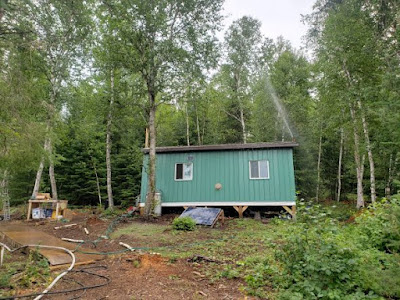 |
The dark clouds on the evening horizon, as late as Sept. 29 when this photo was snapped, were still smoke clouds
|
As I plugged away on building our new cabin at Red Lake this summer, the thought occurred to me that I might have made a mistake. Maybe we should have bought an RV for our retirement instead, something that
we could roll to a more habitable place. This was the second time in three years when summer at Red Lake was something to endure, not enjoy.
Baking heat and choking smoke from forest fires -- again --seemed to say, "Welcome to the ghost of future climate change."
A million acres were on fire to our west in Woodland Caribou Provincial Park and just a bit farther, in adjoining Atikaki Provincial Park in Manitoba and areas to the northwest, a similar area was ablaze. These were the colossal fires but there were many others as well. In fact, at one time there were 100 fires going just in the Red Lake district. It was like Armageddon.
Remote northern communities were being evacuated everywhere. These were mostly First Nations. Summer evacuations have become so common for them it is getting hard to remember when they weren't forced to spend months in a cramped hotel room or on a cot in an arena. Red Lake was put on evacuation notice. Seniors and hospital patients were taken elsewhere. Sprinklers were put up completely around the town's perimeter. Many residents stayed inside much of the time to escape the heat and smoke. The hardware stores brought in window air conditioners by the pallet-load.
As bad as it seemed we knew we were fortunate. Out in British Columbia people were dying by the hundreds from the heat. One mountain town -- Lytton -- set a heat record for Canada at 49.6 C or 121.3 F. That was just before the whole place caught on fire and burned to the ground.
The fire season in Red Lake began in May and just got worse and worse. It was hot and dry from the get-go. By mid-June the smoke was so thick boaters were finding their way by GPS to the west end of the lake where we are building. You couldn't see the shoreline. It wasn't obvious where the fires were because we couldn't see a darn thing, sometimes not even a pale sun.
And in a really weird weather phenomenon, there was no wind, day after day, week after week. When you looked at the smoke forecasts on weather sites like FireSmoke.ca the smoke blob over the Red Lake area moved around like a lava lamp. The smoke blanket prevented the lake water from warming up as much as you would expect from the 36 C (97 F) daytime air temperature.
The smoke was so thick that water bombers and helicopters couldn't fly. Those enormous fires just west of us us went untouched for about a month, from the time they might have been extinguished until they had grown too large to control. It is a policy in Woodland Caribou that forest fires which start naturally from lightning should be allowed to burn. At least, that is the policy for some areas of the park. In other areas the new fires would be extinguished by the MNRF. As it turned out this year, the two mega fires began in areas that could have been fought. They weren't, apparently because firefighters were overwhelmed by all the other blazes. And it was too smoky to fly as well.
We never saw a water bomber this summer. Once the crisis had abated, at least somewhat -- we had one pretty good rain -- helicopters attacked the fire just beyond Trout Bay from before sunup to nearly dark for weeks.
It was obvious to me that the situation this past summer represented a paradigm shift in fire intensity and in weather. We now need a similar paradigm shift in firefighting strategy. For starters, now that climate change is happening exponentially from one year to the next, we need to scrap the policy that lets fires burn anywhere in Northern Ontario, be they in the wilderness park or in the Far North. We just can't be sending billions of tons of CO2 into the atmosphere any more. This means a war-like expansion of our firefighting capability. We don't just need a dozen more water bombers and fire crews, we need hundreds, and they need to be positioned way up North as well as in road-accessible communities like Red Lake.
Besides the CO2 liability, forest fires are killing us with their smoke. It isn't only people with asthma; it's all of us.
Is this going to cost money? Of course, but there is no alternative. We have done nothing about climate change up to this point and this is the price we must pay. The Amazon Rain Forest was found this year to be a contributor to CO2 rather than a sink. The Boreal Forest is about to do the same and then we will have hell to pay.








